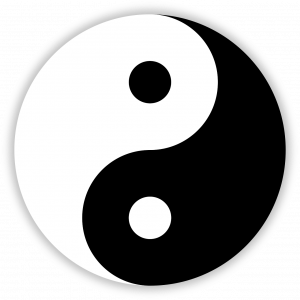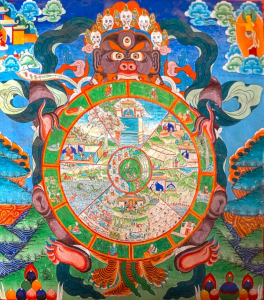8 Religion and Culture
Eliza Rosenberg
LECTURER IN RELIGIOUS STUDIES
& SPECIAL GUEST CONTRIBUTOR
Suggested Focus
Keep the following questions in mind as you read the chapter.
- What is the origin of the word religion? How do the words “religion” and “culture” seem to overlap in meaning?
- What are some words in other languages that seem to correspond to the word religion?
- What is religion NOT?
- What are some important questions that religions often seek to answer?
- What are some different aspects of daily living that are often regulated by religious rules?
What is religion?

What do we mean when we say “religion”? In some ways, the answer seems obvious. Most people can tell you that they are atheist, Buddhist, Christian, Daoist, Hindu, Jewish, Muslim, etc. In other ways, the answer is more complicated. The English word “religion” comes from the Latin word religio. Ancient Roman philosophers actually disagreed about where the word came from, and modern scholars are not sure either. Still, most ancient Romans knew what religio meant. They used the word for their rituals, holidays, beliefs, myths, and rules. They also applied it to those of non-Romans around them, such as Greeks, Jews, and Egyptians. But for hundreds of years, Greeks, Jews, and Egyptians did not adopt the Latin word religio or come up with their own words to express the concept. To everyone except the Romans, the things that made up religio– rituals, myths, holidays, rules, etc. – were just part of “the way things were.” They did not need a separate category or term.
Eventually, Christianity became widespread in Rome’s empire, which included Greece, Egypt, and many other places. When the Roman emperor became Christian, Christians – including non-Roman Christians – started to think of Christianity as their religio. The idea of “religion” remained important even after the Roman empire fell. It influenced Judaism and Islam, as well as other religions. Today, many languages have words that were invented or re-interpreted to translate religio. In western Europe, many languages borrowed the Latin religio. In southern Asia today, the ancient Sanskrit word dharma can be used to mean about the same thing as “religion.” (It also has many other meanings.) In Eastern Asia, the Chinese word dao and loan words in neighboring languages works in a similar way.
The term “religion” is useful, but like many words, it is complicated. The concept of “religion” makes sense because there are many elements that you can find in many different religions. But no religion has every single one of these elements, and there is probably no one element that every religion has. In addition, the same element may “mean” different things or “work” in different ways in different religions. For example, Buddhism and Islam both have beliefs about what happens to us when we die. But they have very different ideas about what that is, about what should happen, and even about who “we” are.
For at least the last hundred years, scholars have tried to find a definition of religion that would always be useful and accurate. Although their hard work did not succeed, it has taught scholars today a valuable lesson: There is no perfect definition of religion. Most people more or less understand what they mean when they use the term “religion,” even if they cannot define it perfectly. In this chapter, we will not try to explain what religion “really is.” Instead, we will explore some of the things that different religions are. By doing so, we will understand all of them better. There are many shared features and many differences – not only between different religions, but within the same religion.
Religion and culture are parts of each other. Culture affects religion, and religion affects culture. The same religion can have different forms in different cultures. Within one culture, different religions can take similar forms. And, of course, religion is practiced by people, who are all different.
What religion is not
While religion is many different things, it is also important to know what it (usually) is not. First, religion is not (usually) a way to explain things that people did not understand before modern science. In ancient China, most people did not think that the flesh of the giant Pangu had literally turned into the earth at some exact time. In ancient Israel, most people knew perfectly well that the whole universe was not formed in six days. How could it have been, when there was no sun or moon until the fourth “day”? Every religion has at least one example of this. In ancient times, people did not know the scientific history of the world, and they did not think their religions told them. Stories of the cosmic tortoise, the first human, etc. were (and are) important because people connected with them emotionally and poetically. They allow people to connect personally to the scope of the universe. But they have rarely been pre-scientific answers to complicated questions. In fact, religion has often been the cause of science. We owe modern mathematics to Jain contemplation of the nature of existence; modern chemistry to Muslim ideas about the spiritual virtue of observing nature; some branches of physics to the Christian scholastic movement of the middle ages; and many scientific ideas to various Daoist practices.
Second, religion is not “really about” any one simple aspect of life. People who like religion sometimes say that it expresses the highest human ideals; that it makes communities strong; that it inspires goodness; that it inspires people; and so on. People who dislike religion sometimes say that it is used to control people; that it is connected with ignorance; that it supports corrupt power; that it provides false reassurances; etc. All of these things can be true. Religion can and does promote good order and oppress people; promote knowledge and ignorance; inspire peace and violence; etc. It is not possible to reduce religion to a single, simple factor. Religion is dynamic and complex, just like the cultures that influence it (and that it influences) – and just like the people who practice it (or don’t practice it).
The world’s religions
There are probably more religious identities in the world than there are religions!

That is because it can be possible to be part of more than one religion at a time. For example, many European Christians feel that you cannot be a Christian and any other religion, but many Native American Christians feel that it is possible to practice Christianity without abandoning their ancestral religions. In Japan, most people practice both Buddhism and Shinto and identify themselves accordingly. In traditional China, Buddhism, Confucianism, and Daoism were known as the “three great teachings,” and it was assumed that people should learn from all of them. To be a Christian is to commit to a religion that relies on Judaism for its very existence. To be a Buddhist is to be an heir to the defining concepts of Hinduism. To be an atheist is sometimes to choose a specific system of thought as a reaction to a particular religion. And so on.
Some common religious questions
Where do human beings fit into the universe?
Religion, like culture, is something that humans do. This may seem obvious, but it is not a statement that all religions would find meaningful. In traditional Native American religions, for example, there is no part of existence that is separated from the sacred. Of course, humans play a unique, human role in this – just as bears play a unique, ursine role in it; rivers a unique river role; etc. And Daoism teaches that “alone among the ten thousand things, humans must be taught to follow the dao.” That is, everything else that exists is naturally part of the harmonious flow of the dao. The fact that human beings need philosophy, religion, etc., shows that there is something wrong with us!

Most Native American religions see human beings as one kind of being among many. Just as human beings have their own communities, social rules, life histories, and individual personalities, so do all other animals. If human beings are different from all other animals, according to these religions, it is usually because we are worse! Until recently, most Native Americans were hunter-gathers, and many today hunt and gather as well as buying farmed food at grocery stores. In Native American thought, hunted animals voluntarily give up their lives to let humans eat. But human beings are not as generous, – no animal native to North or South America normally preys on human beings. (Only a handful – polar bears; grizzly bears; mountain lions; and alligators – prey on humans at all, and even then, it is rare.) Human beings are seen as more selfish than animals, whereas animals are altruistic.
Judaism and Christianity both teach that God allows human beings to rule over the rest of nature. Today, many Jews and Christians interpret this as meaning that human beings have a responsibility to care for nature. But some today, like many in earlier times, interpret this as permission to use nature however they want. Islam’s concept has a subtle but critical difference. Muslims believe that God entrusted human beings with the responsibility to administer the natural world, but that, rather than being worthy of God’s trust, humanity all too often “has proved [to be] a sinner and a fool.”

Many religions that believe in reincarnation also place human beings in a special category. In Buddhism, the human realm is one of six realms in which it is possible to be born (the other five are divine; heavenly; animal; hungry-ghost; and hell). In Jainism, it is one of four (the other three are heavenly; animal; and hell). Both Jainism and Buddhism teach that you can only gain enlightenment during a human birth. If you are born into another realm, you can proceed toward enlightenment, but you can only actually reach it as a human. Hinduism tends to think that being human is helpful for reaching spiritual liberation, but not actually necessary. Although it is less likely, a soul certainly can attain liberation while existing as a flower, a butterfly, or whatever else. In addition, all these religions teach that the human realm is a high-risk birth. Human beings can think abstractly and make moral choices, which is beneficial for true understanding. But by the same token, we can choose ignorance, embrace delusion, and practice cruelty in a way that no other creature can, and all too often, we in fact do these things. This earns us (bad) karma and moves us away from liberation instead of toward it.
What happens when we die?

It is easy to become curious about death. When someone we love dies, are they gone forever? Will we ever see them again? Different religions have different ideas answers to these questions, and different members of the same religion may also give different answers. In general, though, most Jews, Christians, and Muslims believe that each human being comes into existence either when they are born or in the mother’s uterus, lives out one lifetime, and then dies. They did not live before this and they will not be born again after this. Instead, these religions teach, God will judge them for how they lived. They believe that God is kind and forgives people for making mistakes, and that because of God’s kindness, “good enough” people exist at peace with God after they die. This existence may be called Heaven or Paradise. Most Jews, Christians, and Muslims say that it is impossible to understand it fully in this life. Instead, they use metaphors and comparisons. For example, Muslims may say that Paradise is like a beautiful garden of fruit trees, or Christians that Heaven is like a beautiful city filled with fruit trees. In Judaism, it is more common to say that we will know “in God’s own time” but not before. As long as we live in this world, we should focus on doing what it is right. All of these religions teach that people who insist on choosing evil will be punished. For example, a murderer who refuses even to admit their actions were wrong might be punished in Hell, kept out of Paradise, or just be completely “gone” when they die.
In contrast, Hindus, Jains, Buddhists, and Sikhs believe in reincarnation (literally, “being put back in flesh”). This is the idea that after death, the soul – the essence of the person – is born again in another form. How you are born depends on how well you lived in your previous life. If you live wrongly, your soul earns karma (or bad karma, according to Buddhists) that you must burn away through suffering (punishment) and then living rightly. Right now, you are a human being, but you might previously have been a tree or a deer, and that you could be a tree or a deer or a different human in a future life. The goal is to stop being reincarnated, which is possible when you no longer have any karma (or only have good karma, according to Buddhism) and have reached spiritual enlightenment. Hindus call this moksha and believe that it means being fully aware that the individual soul is not truly separate from the universal soul. After that, it is no longer necessary to exist any one individual (who, after all, exists only by being separate from every other individual). Buddhists call it nirvana and believe that it means understanding that the soul is only an illusion. Jains believe that the enlightened individual remains an individual but no longer needs a body, instead existing forever as a being of pure light. Sikhism envisions something more similar to the Muslim idea of jinnah, Paradise.
Other religions do not have single, obvious ideas about what happens after we die. Traditional Native American religions, for example, did not see the soul or personality as being completely different from the body, and they did not believe that humans were somehow apart from the rest of the world. Human beings were part of the world before they lived, a part of the world while they lived, and a part of the world after they died – just not the same part at each time. Similarly, Daoism has never had a specific teaching about death that all members of the religion would agree on. Instead, it has ideas about timeless flow of the dao and the harmonious cycle of yin and yang. This allows Daoists to have different ideas about reincarnation, heavenly existence, long life on earth, etc. And Confucius taught that we should worry about the afterlife when we get to it! If we spend too much time thinking about what happens after death, it will distract us from how we should behave during life. Many Jews would agree with Confucius.
Where do we look for answers?

Many religions in the world today have a holy book. For most of human history, though, most people learned sacred teachings, stories, and songs by hearing them and repeating them. This is an example of oral tradition, and people could remember many stories, rules, etc., very accurately. (Many societies had a few professional singers and story-tellers, which helped.) Actually, this is a “cost” of universal literacy – when everyone in a society reads regularly from childhood, people’s memories are not as good! In some religions today, such as Native American religions, it is important to many people to keep this oral tradition alive in the religion. Hymns, rituals, and prayers are often the only things that are not written down by people who practice these religions. (All other kinds of literature are very important.) And today, even in religions that have ancient books and members who can all read them, non-written aspects are very important! Here is one example: If you have ever seen a painting or a display showing the birth of Jesus, you will have seen an ox and a donkey with the baby Jesus. The ox and the donkey are nowhere in the Bible! But Christians, even those who read the Bible often, cannot imagine the scene without the animals there. For highly educated Buddhists and Muslims, it is still important to learn mantras and parts of the Qur’ān by heart, and to recite them from memory.
But books are very important in many religions. Most religions with written books have more than one! All schools of Buddhism share the Palī canon, but different Mahayana traditions also have different texts in addition. Hinduism has a vast number of texts in many languages, including ancient hymns and rituals like the Vedas; philosophical texts like the Upanishads; mythological texts called the Puranas; heroic epics such as the Mahabharata and the Ramayana; devotional hymns; etc. No one Hindu community uses all or even most of these texts. Instead, most Hindus see this variety of texts as offering limitless avenues to truth and goodness. Daoism’s central text is the Daodejing, but the Zhuangzi is also extremely important, and so are many of the more than 1,500 books that are included in the Daozhong(“Daoist canon” or “Daoist list”). Today, many Christians and Jews think of the Bible as a book, but this is a mistake. The world “Bible” comes from the Greek biblia, “books” – plural! The Bible is actually a collection of different books, all of which can be printed in a single volume. But until 1500 or so, it was not possible to print all the books in one volume. Earlier Jews and Christians understood that they had “scriptures” (writings) rather than one single book. The Qur’ān in Islam may be an exception to this rule. It is a single book (a book with “chapters”). The Daodejing is also a single book, but the Qur’ān has a unique status in Islam. While Islam has other important religious writings, there is nothing comparable to the Zhuangzi, for example.
There are subtle but important differences in how religions view their books. Many Hindus view the Vedas as divinely revealed in a specific way, but believe that humans have been divinely guided to produce many other texts in different ways. Speaking very generally, Daoists and Buddhists usually emphasize that their texts contain the wisdom of enlightened teachers but consider the “how” of these texts much less important than the “what.” Jews and Christians generally believe that God inspired various human authors to write the books of the Bible. Muslims believe that the Qur’ān always existed and was simply revealed to Muhammad (pbuh). The physical text obviously had scribes (the prophet’s (pbuh) companions, may God be well pleased with them), but they do not believe that the contents have an author.
Religion and right behavior
Religions often have rules that their members are supposed to follow. Within most religions, members may disagree about some of what the rules are and about which rules are most important. In addition, few people (if any!) follow all the rules of their religion perfectly all the time. Nevertheless, rules can be an important part of many people’s religious experience.
There are some basic rules that most religions share. Most of these are very basic rules that non-religious systems also have. For example, no religion allows its members to murder or steal, just as no government allows its citizens to murder or steal. (Of course, murder and stealing unfortunately still occur.) Many religions also have some version of the “Golden Rule”: Treat others the way you want others to treat you; do not do to others what you would not want done to you. This, too, is a rule that every child must be told at some point!
Religious rules apply to many kinds of behavior: Worship; occupation; finance; social structure; marriage; clothing; and countless others. Instead of including all of these, let’s discuss one type of rule – rules about food – as an example.
Example: Rules about food
Native American religions rarely forbid any specific kind of food. However, they usually limit how much people are allowed to hunt and gather. Hunting too much is disrespectful to animals that give up their lives to feed humans. If animal communities feel disrespected, they will go away and not allow hunters to get them. Wasting any part of the animal’s body is also unacceptable, and there are often strict rules about using every part respectfully. For example, among some of the Cree nations (formerly called “tribes”), it is forbidden to speak while eating fresh hunted meat.
One of the most famous religious rules about food is that Jews and Muslims do not eat pork. The Bible states that pigs are unclean and that Jews may not eat them. Most Christians (although not all!) interpret the New Testament to mean that Christians do not need to obey Jewish laws about food. But the Qur’ān also states that pigs are unclean, so Muslims do not eat pork either. The Qur’ān lists several other animals whose meat is forbidden to Muslims, and the Bible has entire categories of land animals, birds, and sea animals whose meat is forbidden to Jews. The reason is always stated to be that these animals are unclean – but in scientific terms, most of them are no dirtier than the animals whose meat is permitted. Judaism also has other food rules – for example, meat products and dairy products must be eaten separately – that are unrelated to cleanliness or health. Jews and Muslims often say that these rules are really about obeying God. Having to think about whether a given food is okay is a reminder to pay attention to God’s will at all times. (It is easy to say that people should not need this reminder, but much harder to apply the principle!) In a similar way, the rule is a daily reminder to Jews and Muslims that they cannot just do whatever they want. There is no obvious practical reason not to eat pork if you want to – but sometimes there seems to be no obvious practical reason to fulfill other desires that, if you think more carefully, might be harmful to others or to you. Obeying food laws (called kosher for Judaism and halal for Islam) is good practice. (Kosher and halal also regulate slaughter to try to limit the suffering of animals as much as possible, but the reason for this is obvious.)

Another widely known religious food rule is that Hindus are strongly encouraged to be vegetarian and strictly forbidden to eat the meat of cows. The reason for encouraging vegetarianism is straightforward: the duty of ahimsa, “not harming.” Eating meat obviously harms animals, so people should not do it. Some schools of Mahayana Buddhism have similar teaching. Of course it is natural for tigers to eat deer and for hawks to eat mice, but for most Hindus (like all Jains and some Mahayana Buddhists), this is not important. Tigers and hawks do not have a choice, but humans do. Or – perhaps it is “natural” for humans to eat meat. But, many Hindus (and others) might counter, it is also “natural” for the human life expectancy to be thirty-five years and for the child mortality rate to be 50% or even higher. We do not accept these things because they are “natural.”
The special prohibition of cows’ meat can seem more complicated to non-Hindus. After all, dairy products (such as milk, yogurt, ghee butter, paneer cheese) are an important part of the diet in many regions of southern Asia, the homeland of Hinduism. If Hindus are willing to drink cows’ milk, why not eat their meat too?
Actually, Hindus do not eat cows’ meat because they drink their milk. Humans take milk as sustenance from dairy cows just as they take milk as sustenance from their mothers. Therefore, a cow is a mother to people as well as calves, and people have a duty to take care of cows just as grown-up children have a duty to take care of their parents. One of the duties of a Hindu son is to provide an appropriate funeral for his parents when they die. For Hindus, eating beef is equivalent to cutting up and eating the dead body of your own mother. As such, it is one of the most serious sins a Hindu could commit, far worse than eating pork would be for a Jew or a Muslim. In fact, Muslims are permitted to eat pork if it is the only way to avoid starvation, and Jews are actually required to do so. But for many Hindus, the (bad) karma that would result from cow-killing is far, far worse than death.
Not every religion has such specific rules about food. Daoist practice, for example, is less likely to forbid specific foods than to have a system of which foods are good to eat (or to avoid) under which circumstances, and why. Christianity also tends not to forbid specific foods, but many Christians would feel that it was sinful to eat the meat of an animal that is considered “special” in their culture. An amusing example: My American Christian auntie, visiting Sweden, was offered a common Swedish food – reindeer meat – by a fellow Christian. She did not want to eat one of Santa Claus’ helpers! Santa’s reindeer are not “officially” Christian, and my auntie had not believed in Santa since she was a small child. But in this case, emotion was more important than “official” religion!
Conclusion
Religion is a complex part of culture, and the two influence each other in many ways. It is impossible to identify one thing that religion is “really” or “always” about. However, there are some questions that are often useful to ask. Indeed, asking questions can be the most important part of understanding religions! It is best to think about different possibilities, rather than try to find the one “right answer” to any of these questions. Thinking about the possibilities can enrich our understanding of religions, the people who practice them, and the communities in which they live.
Application
- Do you identify with any particular religion? Why or why not?
- What do you believe happens to a person when they die?
- Do people in your home community observe any religiously prescribed rules?
- Do you think it is possible to adhere to more than one religion? Why or why not?
For Further Reading
Ambalu, Shulamit, et al., editors. The Religions Book: Big Ideas Simply Explained. DK Publishing, 2013.
Bowker, John. World Religions: The Great Faiths Explored & Explained. DK Publishing, 2006.
Hinnells, John R. The Penguin Handbook of World Religions. Penguin Books, 2010.
Mooney, Carla, and Lena Chandhok. Comparative Religion: Investigate the World through Religious Tradition. 2015.
Shouler, Kenneth A., and Robert Pollock. The Everything World’s Religions Book: Discover the Beliefs, Traditions, and Cultures of Ancient and Modern Religions. Adams Media, 2010.
Smith, Huston. The World’s Religions. HarperOne, 2009.
Image Attributions
Image 1: “Jerusalem_Western Wall_4_Noam Chen_IMOT” byIsrael_photo_gallery is licensed under CC BY-ND 2.0
Image 2: Klem, Public domain, via Wikimedia Commons
Image 3: Medicine Wheel, Palatki Heritage Site and Ruins, Coconino National Forest, AZ. Pixabay License.
Image 4: Tibetan Buddhist Wheel of Life. Pixabay License.
Image 5: The Christian Eucharist. Pixabay License.
Image 6: Person reading the Qur’an. Pixabay License.
Image 7: Indian vegetarian thali sampler plate. Pixabay License.

